Well you either enjoy the seeding and bubble discussions that happen every year from Selection Sunday through the next Wednesday or not. There seems to be very few folks that fall in between those extremes. I always enjoy making fun of the talking heads that remove all doubt concerning which side of the 100 IQ line they fall on.
But it’s much easier to sit on the sidelines and ridicule than to get down in the dirt and struggle with actually making decisions where moving one team into the field means you have to move someone out. Too often the media concentrates moving teams in without bothering to count to 68 total teams. As I’m writing this intro, I don’t know who will provide me the most entertainment/frustration…the media or the NCAAT Selection Committee. But I’ll have room and time to discuss that below our pre-show analysis.
Using “Last Four In” and “First Four Out” lists from Lunardi (ESPN), Palm (CBS), and the professors behind the Dance Card, here is a list of teams that likely summarize some of the Selection Committee’s toughest decisions:
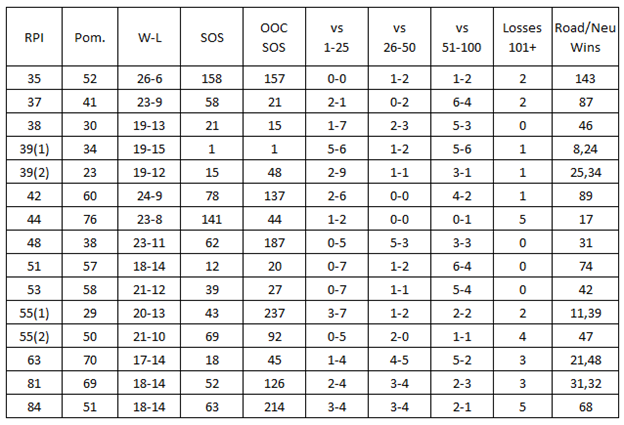
Notes:
- Info from ESPN that frequently has small differences with the NCAA’s official numbers. But make my life easier by preparing most of the columns we need for a blind analysis.
- Yes, we had RPI ranking ties at #39 and #55.
- Pomeroy rankings are included for information and possibly future analysis discussions.
- I manually added a column for bad losses, even though it’s not clear how important they are.
- I also manually added a column for Top50 road or neutral wins OR the best road/neutral win for each of our candidate teams.
Now one of the big advantages the Selection Committee has when it reaches the tough part of the selection process is that they know how many spots they have left…and right now I do not. So for today’s exercise, pick five teams that are definitely in and five that are definitely out based on whatever criteria you value. My guess on Sunday morning is that we’ll end up with more than five in both categories, so picking five should be easy, right?
I decided on this approach weeks ago. But it turns out to be harder than I expected. With the team names hidden, here were my easy decisions:
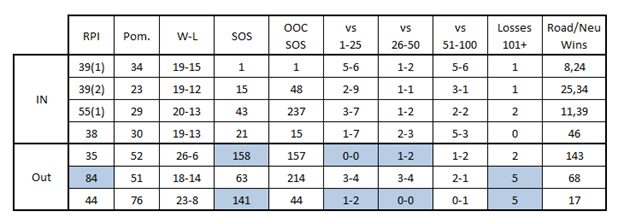
Discussion:
IN
#39(1) probably really isn’t a bubble team. Five Top 25 wins (two on the road) with #1 SOS shouldn’t take long to move this team in. Their seven losses to 51+ probably pushed them down everyone’s rankings…and rightly so. But an easy decision when you start measuring midgets.
#39(2) shares many similarities with the team they share an RPI ranking with. But #39(2) loses out on comparison with the positives but offsets that with fewer negatives. They easily surpass the Sendek Standard that we’ve explored/discussed many times in the past.
#55(1) has an OOC SOS that is approaching concern, but is offset by their positives. Four Top50 wins (two on road) is more than good-enough for me.
#38 has few outstanding accomplishments, but they also have relatively few things to be embarrassed about. I’m not enthusiastic about the resume, but it should be good enough.
OUT
I highlighted the negatives that put them on my NIT list.
#35 and #44 both hit my gag reflex, even though teams like these get into the NCAAT from time to time (ie Wichita St last year). They played no one to speak of and their accomplishments fall below the Sendek Standard (similar to Boomer’s Mendoza Line). #44 digs the hole even deeper with their horrible losses.
#84 makes for interesting discussion. How do you balance six Top 50 wins to go with five embarrassing losses? You could argue this one for days without changing anyone’s mind on either side of the argument. Add in a less-than-inspiring OOC schedule and producing nothing on the road moves them to the NIT on my list….not to mention the fact that their RPI ranking is far below any team that has ever received an at-large bid.
Side Note: As I said last week, I have no idea what to do with Pomeroy’s rankings. So I found it interesting that you could use his rankings as justification for my easy IN/OUT picks. Starting this year, we’ll add this info and see if it’s useful or not.
That left me with the following teams and I tried coloring in the boxes to help with my decisions:
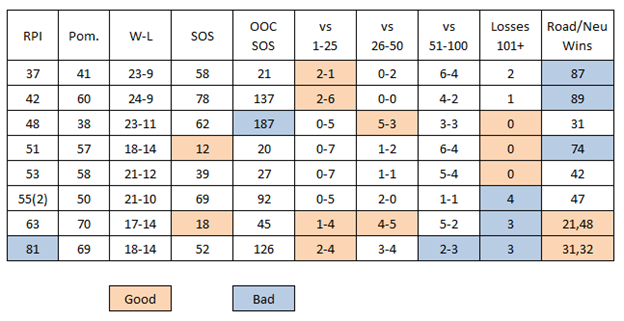
#81 is another conundrum. Six losses to teams that most likely won’t get an at-large bid to the NCAAT combined with five Top 50 wins with two coming on the road. In the past, I’ve used teams with similar bad losses as proof that the Selection Committee doesn’t look at this category. But last year, the Selection Committee Chairman used bad losses as one of several reasons that a mid-major was passed over. So do whatever you think is best with this team, but consider that their RPI is worse than any team invited in the past and is about 10 spots worse than the Syracuse team that many thought should have been left out last year. I put them in the NIT.
#55(2) was my last of five on the OUT list. Nothing really outstanding and four bad losses.
Here were the four teams that I seriously considered for my last of five to put IN:
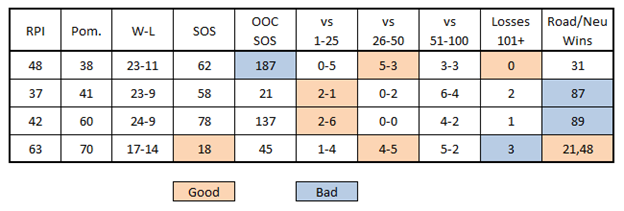
In the end, I decided that Top 50 wins, road wins, and bad losses would be my deciding points and put #48 in my last spot. There are reasons to argue for any of the other three teams and I seriously hope that more than one from this list makes it into the NCAAT.
So here are my selections with their name turned on along with what the NCAAT Selection Committee decided:
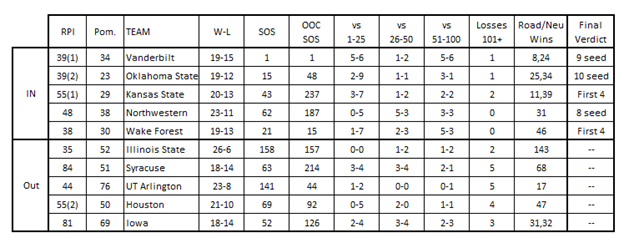
And the original 15 team list (note that RI got the A10 automatic bid)
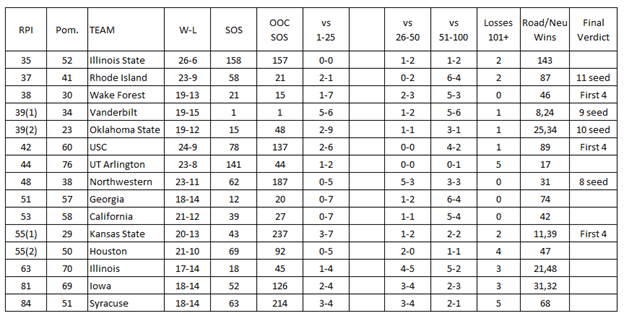
Providence is in the First Four and I didn’t see them on any list near the bubble burst. Providence was #37 on the Dance Card, with #49 the last team in.
For the first time that I remember, the talking heads on CBS didn’t have a mid-major to champion as a wronged team. They only talked about Wichita St’s seeding and the power rankings….while ignoring the fact that Scary Wheat played no one and got their Pomeroy (et al) high rankings by beating up on a bunch of nobodies.
So we didn’t set a new record-high for an RPI ranking to get an at-large bid, but we did break a record. Vanderbilt is the first team with 15 total losses to get an at-large bid.
Looking quickly, the Pomeroy rankings mostly agree with the logic I’ve been using for a while. So I don’t think we gained any info on whether or not the Selection Committee using Pomeroy’s rankings…or if they actually used it at all.
So if the talking heads won’t cooperate by giving me someone to make fun of, I guess I’ll publish this and see what you saw. As always, link articles in the comments that discuss anything about the selection process.



